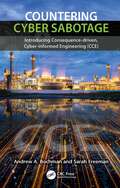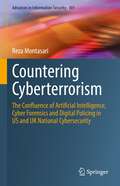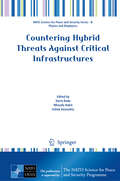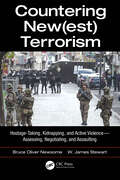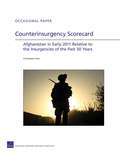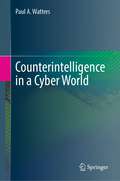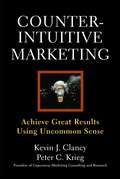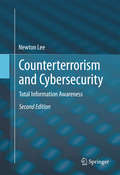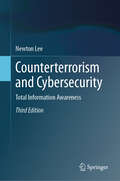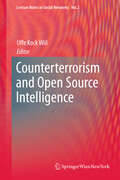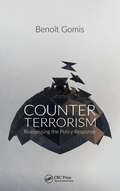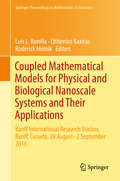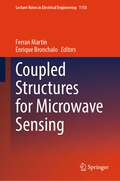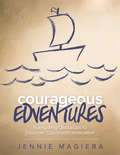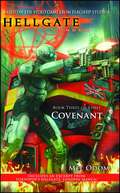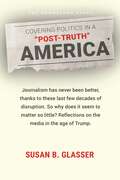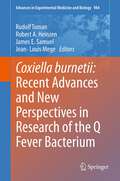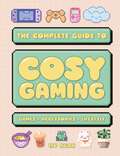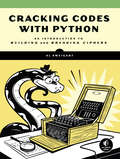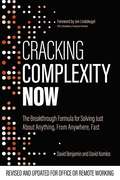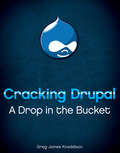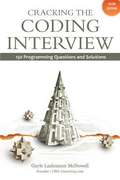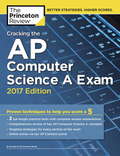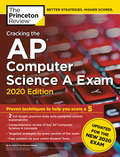- Table View
- List View
Countering Cyber Sabotage: Introducing Consequence-Driven, Cyber-Informed Engineering (CCE)
by Sarah Freeman Andrew A. BochmanCountering Cyber Sabotage: Introducing Consequence-Driven, Cyber-Informed Engineering (CCE) introduces a new methodology to help critical infrastructure owners, operators and their security practitioners make demonstrable improvements in securing their most important functions and processes. Current best practice approaches to cyber defense struggle to stop targeted attackers from creating potentially catastrophic results. From a national security perspective, it is not just the damage to the military, the economy, or essential critical infrastructure companies that is a concern. It is the cumulative, downstream effects from potential regional blackouts, military mission kills, transportation stoppages, water delivery or treatment issues, and so on. CCE is a validation that engineering first principles can be applied to the most important cybersecurity challenges and in so doing, protect organizations in ways current approaches do not. The most pressing threat is cyber-enabled sabotage, and CCE begins with the assumption that well-resourced, adaptive adversaries are already in and have been for some time, undetected and perhaps undetectable. Chapter 1 recaps the current and near-future states of digital technologies in critical infrastructure and the implications of our near-total dependence on them. Chapters 2 and 3 describe the origins of the methodology and set the stage for the more in-depth examination that follows. Chapter 4 describes how to prepare for an engagement, and chapters 5-8 address each of the four phases. The CCE phase chapters take the reader on a more granular walkthrough of the methodology with examples from the field, phase objectives, and the steps to take in each phase. Concluding chapter 9 covers training options and looks towards a future where these concepts are scaled more broadly.
Countering Cyberterrorism: The Confluence of Artificial Intelligence, Cyber Forensics and Digital Policing in US and UK National Cybersecurity (Advances in Information Security #101)
by Reza MontasariThis book provides a comprehensive analysis covering the confluence of Artificial Intelligence (AI), Cyber Forensics and Digital Policing in the context of the United Kingdom (UK), United States (US) and European Union (EU) national cybersecurity. More specifically, this book explores ways in which the adoption of AI algorithms (such as Machine Learning, Deep Learning, Natural Language Processing, and Big Data Predictive Analytics (BDPAs) transforms law enforcement agencies (LEAs) and intelligence service practices. It explores the roles that these technologies play in the manufacture of security, the threats to freedom and the levels of social control in the surveillance state. This book also examines the malevolent use of AI and associated technologies by state and non-state actors. Along with this analysis, it investigates the key legal, political, ethical, privacy and human rights implications of the national security uses of AI in the stated democracies. This book provides a set of policy recommendations to help to mitigate these challenges. Researchers working in the security field as well advanced level students in computer science focused on security will find this book useful as a reference. Cyber security professionals, network security analysts, police and law enforcement agencies will also want to purchase this book.
Countering Hybrid Threats Against Critical Infrastructures (NATO Science for Peace and Security Series B: Physics and Biophysics)
by Ashok Vaseashta Dorin Radu Mirsada HukićThis proceedings volume presents a collection of articles from key practitioners from relevant areas with experience in critical infrastructure. The authors acknowledge that the responsibility for critical infrastructure protection is primarily a matter of international importance, hence a high degree of cross-border and cross-sectoral interdependencies must be coordinated or, where appropriate, legally harmonized efforts at the international level, including the smooth functioning of the internal policies. The book focuses on countering hybrid threats that render critical infrastructures vulnerable. An understanding of such threats will render critical infrastructure safe, secure, and resilient. The protection of national critical infrastructures, as well as of the functions and services critical to the proper functioning of society is a key priority and requires a new unique and strategic approach. Work in this direction must consider the strong interdependencies between the various critical functions and services, including financial services, the key role of the private sector, the changing security environment, and emerging risks, both in the physical and cyber fields. In addition to legal requirements, agreements should be promoted with private sector infrastructure and service owners and operators to ensure the continuity of and access to critical services, including beyond force majeure, by ensuring an acceptable level of preparedness to respond. all relevant threats, as well as the flexibility to address and mitigate the effects of low-probability, high-impact events.
Countering New(est) Terrorism: Hostage-Taking, Kidnapping, and Active Violence — Assessing, Negotiating, and Assaulting
by Bruce Oliver Newsome James W. StewartHow should we analyze and assess new terrorist behaviors? What are the particular risks and challenges from new terrorism? Should we negotiate with terrorists, and, if so, how? When should we use force against terrorists? Countering New(est) Terrorism: Hostage-Taking, Kidnapping, and Active Violence—Assessing, Negotiating, and Assaulting improves our knowledge of new terrorist behaviors, and our skills in responding to such attacks.The term "new terrorism" has been in circulation since the late 90’s. This book analyzes the "newest terrorism" that has emerged in recent years—characterized by increased hostage-taking, kidnapping, and active violence—and develops best practices for countering these emerging threats. Along the way, it challenges fashionable wishful thinking that all terrorists are open to rational negotiation or de-radicalization, that military responses always reflect badly on the official side, and that terrorists are not constrained by their own doctrines.The new terrorists are dramatically more ideological, murderous, and suicidal. They are generally less reconcilable, less trusting of official negotiators, less likely to release detainees, and more likely to kill detainees. They are less likely to demand ransoms yet more likely to release hostages in cases in which they do demand ransom. They are more informed about the official side’s policies, tactics, techniques, and procedures. They are more likely to use new information and communication technologies against responding agencies and officials. They are more capable fighters—they kill more people despite deploying fewer fighters per hostage. Most disturbing is the fact that they take advantage of free-er societies to access easier targets. Features: Includes evidence-based definitions and descriptions of political, religious, Jihadi, and new terrorism Presents the first large-n comparison of old and new terrorism, using an original extension of the Global Terrorism Database (GTD), with added codes for each of 10,735 hostage crises and more than 500,000 data points from 1970 through 2016 Details a further extension of the GTD covering all terrorist events from 2004 through 2016, roughly 5 million data points. Offers prescriptive advice and visual decision trees on how to negotiate crises, assess the risk of terrorism, and how and when to assault terrorists Reviews official practices, interviews with experienced officials, and real-world simulations of recent terrorist events and attacks Countering New(est) Terrorism will be of interest to researchers, students enrolled in terrorism and Homeland Security programs, crisis negotiators, and police, security, intelligence, and military authorities tasked with counterterrorism and anti-terrorism efforts.
Counterinsurgency Scorecard: Afghanistan In Early 2011 Relative to the Insurgencies of the Past 30 Years
by Christopher PaulA core finding of previous RAND research on 30 years of insurgencies worldwide was that a conflict's overall score on a scorecard of 15 equally weighted good and 12 equally weighted bad counterinsurgency factors and practices perfectly predicted the ultimate outcome. Using the scorecard approach and an expert elicitation (Delphi) exercise, a RAND project sought to extend the findings to the case of Afghanistan in early 2011.
Counterintelligence in a Cyber World
by Paul A. WattersThis book provides an outline of the major challenges and methodologies for applying classic counterintelligence theory into the cybersecurity domain. This book also covers operational security approaches to cyber, alongside detailed descriptions of contemporary cybersecurity threats, in the context of psychological and criminal profiling of cybercriminals. Following an analysis of the plethora of counterespionage techniques that can be mapped to the cyber realm, the mechanics of undertaking technical surveillance are reviewed.A range of approaches to web and forum surveillance are outlined as a virtual addition to traditional video and audio surveillance captured regarding targets. This includes a description of the advances in Artificial Intelligence, predictive analysis, support for the disciplines of digital forensics, behavioural analysis and Open Source Intelligence (OSINT). The rise of disinformation and misinformation and the veracity of widespread false flag claims are discussed at length, within the broader context of legal and ethical issues in cyber counterintelligence.This book is designed for professionals working in the intelligence, law enforcement or cybersecurity domains to further explore and examine the contemporary intersection of these disciplines. Students studying cybersecurity, justice, law, intelligence, criminology or related fields may also find the book useful as a reference volume, while instructors could utilise the whole volume or individual chapters as a secondary textbook or required reading.
Counterintuitive Marketing: Achieving Great Results Using Common Sense
by Kevin J. Clancy Peter C. KriegWhy does American business seem to sputter along where it ought to thrive? What is the source of the current plague of downsizing, disappearing companies, dot-com crashes, and here-today-gone-tomorrow advertising campaigns? Why do more products flop than ever before? Marketing experts Kevin J. Clancy and Peter C. Krieg have the answers. In Counterintuitive Marketing, Clancy and Krieg trace the high rate of business failure back to bad marketing strategy, and the even worse implementation of that strategy. Excess testosterone, they argue, compels senior managers to make decisions intuitively, instinctively, quickly, and, unfortunately, disastrously. In this informative and enlightening book, Clancy and Krieg confront these "over-and-over-again" marketers, who don't have time to do it right the first time, but endless time and a company bankroll to do it wrong over and over again. The authors draw from their decades of consumer and business-to-business marketing experience to describe the intuitive decision-making practices that permeate business today, and demonstrate how these practices lead to disappointing performance. Chapter by chapter, Counterintuitive Marketing contrasts how marketing decisions are made today with how they should be made. The authors give equal treatment to targeting, positioning, product development, pricing, customer service, e-commerce, marketing planning, implementation, and more as they present counterintuitive ideas for building and introducing blockbuster marketing programs. Readers will discover in this iconoclastic treasure chest hundreds of penetrating insights that have enabled the authors' firm, Copernicus, to transform companies and become a "brand guardian" to the Fortune 500 and emerging businesses around the world. The tools to create exceptional marketing programs really do exist, and they are all here in Counterintuitive Marketing, the ultimate practical guide for any company of any size.
Counterterrorism and Cybersecurity: Total Information Awareness
by Newton LeeImagine James Bond meets Sherlock Holmes: Counterterrorism and Cybersecurity is the sequel to Facebook Nation in the Total Information Awareness book series by Newton Lee. The book examines U.S. counterterrorism history, technologies, and strategies from a unique and thought-provoking approach that encompasses personal experiences, investigative journalism, historical and current events, ideas from great thought leaders, and even the make-believe of Hollywood. Demystifying Total Information Awareness, the author expounds on the U.S. intelligence community, artificial intelligence in data mining, social media and privacy, cyber attacks and prevention, causes and cures for terrorism, and longstanding issues of war and peace. The book offers practical advice for businesses, governments, and individuals to better secure the world and protect cyberspace. It quotes U.S. Navy Admiral and NATO's Supreme Allied Commander James Stavridis: "Instead of building walls to create security, we need to build bridges." The book also provides a glimpse into the future of Plan X and Generation Z, along with an ominous prediction from security advisor Marc Goodman at TEDGlobal 2012: "If you control the code, you control the world." Counterterrorism and Cybersecurity: Total Information Awareness will keep you up at night but at the same time give you some peace of mind knowing that "our problems are manmade -- therefore they can be solved by man [or woman]," as President John F. Kennedy said at the American University commencement in June 1963.
Counterterrorism and Cybersecurity: Total Information Awareness
by Newton LeeCounterterrorism and cybersecurity are the top two priorities at the Federal Bureau of Investigation (FBI). Graduated from the FBI Citizens Academy in 2021, Prof. Newton Lee offers a broad survey of counterterrorism and cybersecurity history, strategies, and technologies in the 3rd edition of his riveting book that examines the role of the intelligence community, cures for terrorism, war and peace, cyber warfare, and quantum computing security. From September 11 attacks and Sony-pocalypse to Israel’s 9/11 and MOAB (Mother of All Breaches), the author shares insights from Hollywood such as 24, Homeland, The Americans, and The X-Files. In real life, the unsung heroes at the FBI have thwarted a myriad of terrorist attacks and cybercrimes. The FBI has worked diligently to improve its public image and build trust through community outreach and pop culture. Imagine Sherlock Holmes meets James Bond in crime fighting, FBI Director Christopher Wray says, “We’ve got technically trained personnel—with cutting-edge tools and skills you might never have imagined seeing outside of a James Bond movie—covering roughly 400 offices around the country.” This book is indispensable for anyone who is contemplating a career at the FBI, think tanks, or law enforcement agencies worldwide. It is also a must-read for every executive to safeguard their organization against cyberattacks that have caused more than $10 billion in damages. In the spirit of President John F. Kennedy, one may proclaim: “Ask not what counterterrorism and cybersecurity can do for you, ask what you can do for counterterrorism and cybersecurity.” Praise for the First Edition: “The book presents a crisp narrative on cyberattacks and how to protect against these attacks. … The author views terrorism as a disease that may be cured through education and communication. … The book is a relevant, useful, and genial mix of history, current times, practical advice, and policy goals.” - Brad Reid, ACM Computing Reviews “Very professional and well researched.” - Eleanor Clift, Newsweek and The Daily Beast
Counterterrorism and Open Source Intelligence (Lecture Notes in Social Networks #2)
by Uffe WiilSince the 9/11 terrorist attacks in the United States, serious concerns were raised on domestic and international security issues. Consequently, there has been considerable interest recently in technological strategies and resources to counter acts of terrorism. In this context, this book provides a state-of-the-art survey of the most recent advances in the field of counterterrorism and open source intelligence, demonstrating how various existing as well as novel tools and techniques can be applied in combating covert terrorist networks. A particular focus will be on future challenges of open source intelligence and perspectives on how to effectively operate in order to prevent terrorist activities.
Counterterrorism: Reassessing the Policy Response
by Benoît GomisCounterterrorism: Reassessing the Policy Response promotes a more nuanced understanding of the effectiveness of current counterterrorism practices and the need for reform. It challenges government, media, and academic accounts that exaggerate terrorist threats, particularly in comparison to other threats such as organized crime. Author Beno�Gomis r
Coupled Mathematical Models for Physical and Biological Nanoscale Systems and Their Applications: Banff International Research Station, Banff, Canada, 28 August - 2 September 2016 (Springer Proceedings in Mathematics & Statistics #232)
by Roderick Melnik Luis L. Bonilla Efthimios KaxirasThis volume gathers selected contributions from the participants of the Banff International Research Station (BIRS) workshop Coupled Mathematical Models for Physical and Biological Nanoscale Systems and their Applications, who explore various aspects of the analysis, modeling and applications of nanoscale systems, with a particular focus on low dimensional nanostructures and coupled mathematical models for their description. Due to the vastness, novelty and complexity of the interfaces between mathematical modeling and nanoscience and nanotechnology, many important areas in these disciplines remain largely unexplored. In their efforts to move forward, multidisciplinary research communities have come to a clear understanding that, along with experimental techniques, mathematical modeling and analysis have become crucial to the study, development and application of systems at the nanoscale. The conference, held at BIRS in autumn 2016, brought together experts from three different communities working in fields where coupled mathematical models for nanoscale and biosystems are especially relevant: mathematicians, physicists (both theorists and experimentalists), and computational scientists, including those dealing with biological nanostructures. Its objectives: summarize the state-of-the-art; identify and prioritize critical problems of major importance that require solutions; analyze existing methodologies; and explore promising approaches to addressing the challenges identified. The contributions offer up-to-date introductions to a range of topics in nano and biosystems, identify important challenges, assess current methodologies and explore promising approaches. As such, this book will benefit researchers in applied mathematics, as well as physicists and biologists interested in coupled mathematical models and their analysis for physical and biological nanoscale systems that concern applications in biotechnology and medicine, quantum information processing and optoelectronics.
Coupled Structures for Microwave Sensing (Lecture Notes in Electrical Engineering #1150)
by Ferran Martín Enrique BronchaloThis book offers a comprehensive and timely review of planar microwave sensors based on coupled structures. Gathering chapters contributed by the most authoritative researchers on this topic, it presents various strategies for sensor performance optimization using coupled lines, directional couplers, and coupled resonators (either distributed or semi-lumped), focusing mainly on sensitivity optimization, and covering chains of coupled resonators as well. The book also reports on analytical methods, design formulas, sensor validation tests, with both simulation and experimental methods, describing some relevant practical applications. Mainly reflecting the research activity carried out by the different contributors in the last years, this book also includes two introductory chapters to help readers who are not very familiar with microwave sensing technologies and coupled structures. All in all, this book addresses advanced graduate students and researchers involved in microwave and sensor technologies, and may be of interest for engineers and professionals as well, working in areas as diverse as wireless sensors and sensor networks, biosensing, chemical sensing, motion control, microfluidics, Internet of Things (IoT), and smart systems.
Courageous Edventures: Navigating Obstacles to Discover Classroom Innovation (Corwin Teaching Essentials)
by Jennie MagieraChart a course to innovation using educational technology Let’s go on an edventure! Do you want to innovate and take risks in your teaching? Looking for ways to troubleshoot common classroom challenges? Whatever obstacles you and your students face can turn into edventures, and this book will show you how to navigate them with grace, humor, and grit. Jennie Magiera charts a course for you to discover your own version of innovation, using the limitless possibilities of educational technology. You will learn: How to create your own Teacher-IEP (Innovation Exploration Plan) Keys to problem-based innovation (PBI) Strategies and solutions for tackling common classroom problems Methods for putting learning into the hands of students How to find innovation in everyday places Packed with real-world, immediately applicable solutions to the problems teachers face in their classrooms every day,Courageous Edventures shows how technology can be a fun and easy tool to improve classroom management and student learning! "Magiera leads people on a journey with some great ideas to get started in the classroom right now, or the inspiration to find your own way, leading to innovative ideas for learning and teaching." George Couros, Author of The Innovator′s Mindset and Innovative Teaching, Learning, and Leadership Consultant "This book does a superb job of providing practical ideas and strategies on how to actually implement innovative practices in today′s classroom. Her knowledge and experience as a change agent further strengthen the techniques presented and will help educators truly envision what′s possible in classrooms today." Eric Sheninger, Corwin Author and Senior Fellow International Center for Leadership in Education
Courageous Edventures: Navigating Obstacles to Discover Classroom Innovation (Corwin Teaching Essentials)
by Jennie MagieraChart a course to innovation using educational technology Let’s go on an edventure! Do you want to innovate and take risks in your teaching? Looking for ways to troubleshoot common classroom challenges? Whatever obstacles you and your students face can turn into edventures, and this book will show you how to navigate them with grace, humor, and grit. Jennie Magiera charts a course for you to discover your own version of innovation, using the limitless possibilities of educational technology. You will learn: How to create your own Teacher-IEP (Innovation Exploration Plan) Keys to problem-based innovation (PBI) Strategies and solutions for tackling common classroom problems Methods for putting learning into the hands of students How to find innovation in everyday places Packed with real-world, immediately applicable solutions to the problems teachers face in their classrooms every day,Courageous Edventures shows how technology can be a fun and easy tool to improve classroom management and student learning! "Magiera leads people on a journey with some great ideas to get started in the classroom right now, or the inspiration to find your own way, leading to innovative ideas for learning and teaching." George Couros, Author of The Innovator′s Mindset and Innovative Teaching, Learning, and Leadership Consultant "This book does a superb job of providing practical ideas and strategies on how to actually implement innovative practices in today′s classroom. Her knowledge and experience as a change agent further strengthen the techniques presented and will help educators truly envision what′s possible in classrooms today." Eric Sheninger, Corwin Author and Senior Fellow International Center for Leadership in Education
Covenant (Hellgate: London #3)
by Mel OdomAs Templar Simon Cross fights to lead the hunted survivors of the demon surge toward salvation, time and supplies run short. Simon must penetrate the dark secrets of the demons -- as well as those of his partner in peril, Leah Creasey -- to keep his charges safe. But Leah's organization won't surrender their knowledge easily, even as new technology emerges from the Goetia Manuscript that could help Simon's cause. Warren Schimmer, linked to one of the darkest of the hellspawn -- the demonic Lilith -- is himself also targeted by infernal forces. No longer able to hide, Warren must emerge as a leader and turn a ragged band of Cabalists into an army. But when a vicious weapon that uses dreams against the human survivors of the city draws the Templars, the Cabalists, and the Hunters into the same arena, will they join forces...or turn against one another?
Covering Politics in a "Post-Truth" America
by Susan B. GlasserIn a new Brookings Essay, Politico editor Susan Glasser chronicles how political reporting has changed over the course of her career and reflects on the state of independent journalism after the 2016 election.The Bookings Essay: In the spirit of its commitment to higquality, independent research, the Brookings Institution has commissioned works on major topics of public policy by distinguished authors, including Brookings scholars. The Brookings Essay is a multi-platform product aimed to engage readers in open dialogue and debate. The views expressed, however, are solely those of the author. Available in ebook only.
Coxiella burnetii: Recent Advances And New Perspectives In Research Of The Q Fever Bacterium (Advances in Experimental Medicine and Biology #984)
by Rudolf Toman James E. Samuel Jean-Louis Mege Robert A. HeinzenCoxiella burnetii is the etiological agent of Q fever, a zoonotic disease found worldwide. The bacterium is a fascinating example of intracellular parasitism that has uniquely evolved to thrive in the most inhospitable of cellular compartments-the phagolysosome. Understanding how C. burnetii resists the degradative functions of this vacuole, and the host cell functions coopted for successful parasitism, are central to understanding Q fever pathogenesis. Recent achievements in glycomics and proteomics are guiding development of enhanced detection schemes for the bacterium in addition to shedding light on the host immune response to the pathogen. Several chapters survey immune functions that control or potentially exacerbate Coxiella infection and delve into correlates of protective immunity elicited by vaccination. Comparative genomics is also the foundation of chapters discussing diagnostic antigen discovery and molecular typing of the bacterium, with significance for development of new clinical, epidemiologic, and forensic tools.
Cozy Gaming
by Liv NganIt's time to put your snuggle top on, cuddle your squishies, and find out all about the cosiest games around! Cosy games include fun, de-stressing, cute and calm games like Stardew Valley, Animal Crossing: New Horizons, Disney Dreamlight Valley, Oxenfree and many more. This book gives you everything you need to focus on diving into the carefree world of cosy gaming, with reviews of the best titles and previews of soon-to-be-released games too. No matter how you game - on consoles, online or on mobile devices - there's something here for you.As well as info on the best games to play, this book is also full of ways to cosy-fy your life-including tips for making your bedroom super snuggly, the cutest squishies and plushies, and the ultimate accessories for all-important self-care. You'll discover how to customise your current room to turn it into a den of relaxation, how to find an aesthetic that works for you, and how to choose your ultimate cosy lifestyle. It's everything you need for your perfect cosy life!
Cracking Codes with Python: An Introduction to Building and Breaking Ciphers
by Al SweigartLearn how to program in Python while making and breaking ciphers—algorithms used to create and send secret messages! After a crash course in Python programming basics, you’ll learn to make, test, and hack programs that encrypt text with classical ciphers like the transposition cipher and Vigenère cipher. You’ll begin with simple programs for the reverse and Caesar ciphers and then work your way up to public key cryptography, the type of encryption used to secure today’s online transactions, including digital signatures, email, and Bitcoin.Each program includes the full code and a line-by-line explanation of how things work. By the end of the book, you’ll have learned how to code in Python and you’ll have the clever programs to prove it!You’ll also learn how to:- Combine loops, variables, and flow control statements into real working programs- Use dictionary files to instantly detect whether decrypted messages are valid English or gibberish- Create test programs to make sure that your code encrypts and decrypts correctly- Code (and hack!) a working example of the affine cipher, which uses modular arithmetic to encrypt a message- Break ciphers with techniques such as brute-force and frequency analysisThere’s no better way to learn to code than to play with real programs. Cracking Codes with Python makes the learning fun!
Cracking Complexity: The Breakthrough Formula for Solving Just About Anything Fast
by David Benjamin David KomlosFor the first time, Davis Benjamin and David Komlos of Syntegrity share their cutting-edge, highly engaging step-by-step formula for cracking incredibly knotty and important challenges in mere days, while mobilizing those who must execute. Foreword by Marshall Goldsmith, #1 NY Times bestselling author, Thinkers50 - #1 Executive Coach and the only two-time #1 Leadership Thinker in the WorldComplexity has met its match! Today, organizations are grappling with ambiguity, volatility and paradox surrounding the challenges they face. This is complexity. But too many leaders approach complexity the wrong way - they push their people harder and harder and tackle problems one at a time over months, sometimes even years, and nearly always in a linear fashion. It's like setting a pot of water on "low" and waiting for it to boil. To solve the seemingly intractable challenges that leaders bang their heads against for months - to get the metaphorical water to boil - you must generate a high amount of heat very quickly. In this book, the authors share their proven formula for dramatically shortening the process and solving an organization's toughest challenges in mere days.
Cracking Drupal
by Greg KnaddisonThe first book to reveal the vulnerabilities and security issues that exist in the sites that have been built with Drupal?and how to prevent them from continuing Drupal is an open source framework and content management system that allows users to create and organize content, customize presentation, automate tasks, and manage site visitors and contributors. Authored by a Drupal expert, this is the first book to reveal the vulnerabilities and security issues that exist in the sites that have been built with Drupal?and how to prevent them from continuing. The main goal of this guide is to explain how to write code that avoids an attack in the Drupal environment, while also addressing how to proceed if vulnerability has been spotted and then regain control of security.
Cracking The Coding Interview (5th Edition)
by Gayle Laakmann McdowellThe full list of topics are as follows: The Interview Process This section offers an overview on questions are selected and how you will be evaluated. What happens when you get a question wrong? When should you start preparing, and how? What language should you use? All these questions and more are answered. Behind the Scenes Learn what happens behind the scenes during your interview, how decisions really get made, who you interview with, and what they ask you. Companies covered include Google, Amazon, Yahoo, Microsoft, Apple and Facebook. Special Situations This section explains the process for experience candidates, Program Managers, Dev Managers, Testers / SDETs, and more. Learn what your interviewers are looking for and how much code you need to know. Before the Interview In order to ace the interview, you first need to get an interview. This section describes what a software engineer's resume should look like and what you should be doing well before your interview. Behavioral Preparation Although most of a software engineering interview will be technical, behavioral questions matter too. This section covers how to prepare for behavioral questions and how to give strong, structured responses. Technical Questions (+ 5 Algorithm Approaches) This section covers how to prepare for technical questions (without wasting your time) and teaches actionable ways to solve the trickiest algorithm problems. It also teaches you what exactly "good coding" is when it comes to an interview. 150 Programming Questions and Answers This section forms the bulk of the book. Each section opens with a discussion of the core knowledge and strategies to tackle this type of question, diving into exactly how you break down and solve it. Topics covered include Arrays and Strings Linked Lists Stacks and Queues Trees and Graphs Bit Manipulation Brain Teasers Mathematics and Probability Object-Oriented Design Recursion and Dynamic Programming Sorting and Searching Scalability and Memory Limits Testing C and C++ Java Databases Threads and Locks For the widest degree of readability, the solutions are almost entirely written with Java (with the exception of C / C++ questions). A link is provided with the book so that you can download, compile, and play with the solutions yourself.
Cracking the AP Computer Science A Exam, 2017 Edition: Proven Techniques to Help You Score a 5
by Princeton ReviewThis eBook edition has been specially formatted for on-screen viewing with cross-linked questions, answers, and explanations.EVERYTHING YOU NEED TO HELP SCORE A PERFECT 5. Equip yourself to ace the AP Computer Science A Exam with The Princeton Review's brand-new, comprehensive study guide--including 2 full-length practice tests, thorough content reviews, access to our AP Connect online portal, and targeted strategies for every section of the exam.This brand new addition to our best-selling Cracking the AP Exam series is perfect for students tackling the fast-growing AP Computer Science A test. Easy to understand and simple to use, this book gives you all the tools you need to get the score you want.Everything You Need to Know to Help Achieve a High Score.* Comprehensive content review of key Computer Science A topics, including lab requirements* Up-to-date information on the 2017 AP Computer Science A Exam* Engaging activities to help you critically assess your progress* Access to AP Connect, our online portal for helpful pre-college information and exam updatesPractice Your Way to Excellence.* 2 full-length practice tests with detailed answer explanations* Comprehension drills in each content review chapter* Step-by-step walk-throughs of sample questionsTechniques That Actually Work.* Tried-and-true strategies to help you avoid traps and beat the test* Tips for pacing yourself and guessing logically* Essential tactics to help you work smarter, not harder
Cracking the AP Computer Science A Exam, 2020 Edition: Practice Tests & Prep for the NEW 2020 Exam (College Test Preparation)
by The Princeton ReviewEVERYTHING YOU NEED TO HELP SCORE A PERFECT 5. Ace the 2020 AP Computer Science A Exam with this comprehensive study guide—including 2 full-length practice tests, thorough content reviews, targeted strategies for every section of the exam, and access to online extras.Techniques That Actually Work.• Tried-and-true strategies to help you avoid traps and beat the test• Tips for pacing yourself and guessing logically• Essential tactics to help you work smarter, not harderEverything You Need to Know to Help Achieve a High Score.• Comprehensive content review for all test topics, including lab requirements• Up-to-date information on the 2020 AP® Computer Science A Exam• Engaging activities to help you critically assess your progress• Access to study plans, printable resources, helpful pre-college information, and more via your online Student ToolsPractice Your Way to Excellence.• 2 full-length practice tests with detailed answer explanations• Comprehension drills in each content review chapter• Step-by-step walk-throughs of sample questions
